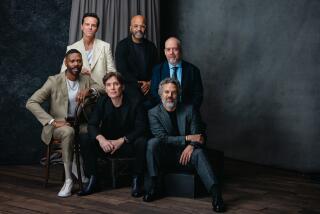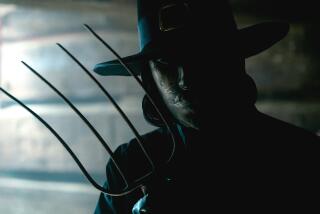The Envelope: Tim Roth reunites with Tarantino in ‘Hateful Eight’

Actor Tim Roth at the Four Seasons Beverly Hills on Dec. 04, 2015.
- Share via
It’s been 23 years since Tim Roth and Quentin Tarantino collaborated on a little genre-busting indie called “Reservoir Dogs.” And the director was still being called “a former video store clerk” when Roth famously opened “Pulp Fiction,” guns a-blazing. Roth returns to the Tarantino tribe in the frontier justice film “The Hateful Eight” with a character written expressly for him: Oswaldo Mobray, the Hangman. The “Lie to Me” star recently talked with the Envelope about being the crisp British foil to a gaggle of rugged travelers stuck in a blizzard in post-Civil War Wyoming.
What does Quentin bring out in you as a performer?
It’s far from naturalism. It’s far from the habit of just whispering your way through a movie. It requires a willingness to jump in and not be worried about embarrassing yourself because he will take care of you. If you look at Christoph [Waltz] in “Inglourious Basterds,” it’s a performance. It’s not just a “keep your head straight, and go in a straight line and hopefully it’ll work out.” You look at Jamie [Foxx] in “Django Unchained.” People are giving an actual theatrical performance in a sense. It’s not often you get that chance. The way he structures and writes his films, it lends itself to that. This one, for example, is like a play.
See more of Entertainment’s top stories on Facebook >>
It actually started as a live reading last year at the Ace Hotel.
[There were] original problems with that scripty-thing. [He smiles at the reference to the script having been leaked online.] The way he dealt with that was to say “OK. Let’s do it. And only the people that sat in the seats that night will get to see the original script.”
In putting together Oswaldo, what came first?
He wrote it for me. He said a very interesting thing, he said, “You hate the upper classes with a real passion. So I wanted to write to that.” If you gave it to someone who was from that, you wouldn’t get the seething, loathing, that kind of sarcastic underbelly to it. I only heard this the other day. It makes complete sense. But then we talked film reference. We both had our things. It kind of came down to [1950s English character actor] Terry-Thomas a little bit. There’s a couple of things in there that are nods to [1980s English actor] Edward Fox from my side that I liked…. There’s a sort of glee in there with a dark underbelly which you just peel back and let the audience see occasionally just to show that nothing is what it seems.
After you see the ending, you realize —
You can go back and look at it and go “Holy … these people are cold!” [Laughs]
What was this set like, compared with your other Tarantino films?
It’s similar to “Reservoir Dogs” in that sense. The films I’ve done with Quentin before were from the early time, if you like. I was going to do “Inglourious Basterds” and couldn’t. Then I would have found out what his new version of a set was like. So I had no idea. Over the years, he has created a way of working. The way he runs the set. It’s very fun. I had a nice healthy gap, and I could see how he’d changed.
How?
First of all, he knows more. He knew a lot to begin with. He just came out of the womb knowing a lot. He never felt like a first-time director to me. Ever. But now, he’s a well-oiled machine. You’ve got to step up and deliver. The crew are the best you can find. He knows exactly what he wants to do and can improvise with the camera. Even in “Pulp Fiction,” you could tell the incline was steep and he was pushing up. He’s very, very, very good with actors.
What does he do?
It’s like he hones in on you. He knows exactly what to say when you’re having a problem. That’s fairly rare. Especially because he shot this in 65mm. You’re on stage. So even that reveals background actors and foreground actors. I watch him as he starts to focus in as the story shifts its focus from one character to the next. I watch him engage them and bring them in and start talking through and joking around and making them feel comfortable and getting them ready and then setting them on a run.
More to Read
Sign up for The Envelope
Get exclusive awards season news, in-depth interviews and columnist Glenn Whipp’s must-read analysis straight to your inbox.
You may occasionally receive promotional content from the Los Angeles Times.







